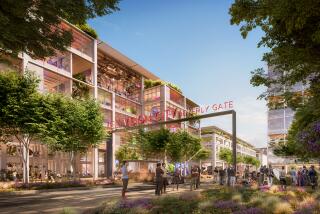Building Stands in Path of Project
- Share via
Los Angeles County supervisors are prepared to vote today on a plan to build a $70-million cultural complex near Olvera Street to celebrate the region’s Mexican American heritage.
There’s just one hitch: Plans for the Plaza de Cultura y Arte include demolishing a historic building.
For the record:
12:00 a.m. Sept. 16, 2004 For The Record
Los Angeles Times Thursday September 16, 2004 Home Edition Main News Part A Page 2 National Desk 1 inches; 41 words Type of Material: Correction
Olvera Street -- An article in Tuesday’s California section about plans for a Mexican American cultural center misspelled the name of Las Angelitas del Pueblo, an organization fighting to save a historic building near Olvera Street, as Los Angelitos del Pueblo.
For The Record
Los Angeles Times Wednesday September 22, 2004 Home Edition Main News Part A Page 2 National Desk 1 inches; 58 words Type of Material: Correction
Mexican American center -- Articles in the California section on Sept. 14 and 15 about Supervisor Gloria Molina’s plans to build a Mexican American cultural center said Los Angeles County does not have any center devoted to that heritage. The Mexican Cultural Institute, whose mission is to preserve Mexican culture, has been operating on Olvera Street since 1990.
Preservationists, although favoring the cultural center, are upset that the plan includes razing a late 19th century building that may have been the first headquarters of the Los Angeles Gas Works.
“Our concern is that a project aimed at preserving Los Angeles’ cultural heritage should not destroy our cultural heritage in the process,” said Ken Bernstein, director of preservation issues for the Los Angeles Conservancy, which works to preserve the area’s cultural and architectural heritage.
Supervisor Gloria Molina, who has sought for years to create the center on the parcel between Spring and Main streets just north of downtown, said plans already call for renovating two other more important historic buildings on the 4.5-acre site, one of which was originally slated for demolition.
Those are the Plaza House, which was built in 1883, and the Vickrey-Brunswig Building, which was built in 1888.
The building at risk, which may have been built as early as 1871, is the Brunswig Drug Company Annex. To rehab it would cost another $5 million, according to the county.
All three brick buildings were condemned more than 30 years ago after fire and earthquake ravaged them, and were abandoned and fenced.
Attempting to spruce them up, officials had blue skies and swirling white clouds painted on the boarded-up windows. The abandoned structures are across Main Street from the better-known Olvera Street, the collection of shops and Mexican restaurants that is celebrated as the birthplace of Los Angeles.
The city owns the buildings on Olvera Street, and the county owns the buildings and land across the street.
Molina said the building slated for demolition “really has no historic benefit,” calling it “nothing but a warehouse.”
“I know there are people who say you should preserve every single brick, just because it is old,” she said. “But we think our plan is very, very dynamic.”
For the most part, the preservationists agree that the 106,500-square-foot complex would fill an unmet need in Los Angeles, which has no center devoted to Mexican heritage although more than 45% of the county’s 10 million residents are Latino. Other cities, including Chicago and San Jose, with smaller Latino populations, have such centers.
Planners envision an educational and cultural complex with a community center for weddings and parties, a 500-seat theater, a 20,000-square-foot gallery for art exhibitions, a genealogical center, and classrooms for dance and art.
The center would be paid for with money from private sources, state grants and, from Molina’s discretionary account, public funds. The La Plaza de Cultura y Artes Foundation, which Molina helped create, would operate the center with about $1 million in annual revenue. More than 134,000 visitors are expected annually.
Molina said officials have talked with the Mexican government about bringing artifacts from Mexico City museums to Los Angeles, and also of working with the Smithsonian Institution in Washington. “This project is long overdue in the community, and we really should be praising the county for having the vision to carry it through,” said Jonathan Yorba, executive director of the Foundation.
Preservationists have no quarrel with that mission. They just don’t understand why a historic building must be razed to accomplish it.
“To lose another historic building in a historic district, which may be the most unique in the United States, is incomprehensible,” said Marilyn Lee, a former Los Angeles Times employee who is the volunteer president of Los Angelitos del Pueblo, which gives guided tours of Olvera Street and the El Pueblo de Los Angeles Historical Monument.
Lee and other docents plan to plead with the supervisors today.
“It’s not gorgeous, like one thinks of historic buildings,” she said, gesturing to the fenced-off, rather shabby exterior of the condemned structures. “But it’s how we started out.”
Rushmore Cervantes, general manager of the city’s Department of El Pueblo, which runs Olvera Street, said one of his employees would testify that the Brunswig Annex is an important historic structure.
Molina said county officials already have compromised by agreeing to save the Vickrey-Brunswig Building, which was initially slated for demolition.
What’s more, she said, the center would make use of two buildings that have been in danger for years.
“If those buildings had stood there, unused, one good earthquake would knock them down,” she said, “and you’d have nothing but a pile of bricks.”
More to Read
Sign up for Essential California
The most important California stories and recommendations in your inbox every morning.
You may occasionally receive promotional content from the Los Angeles Times.










